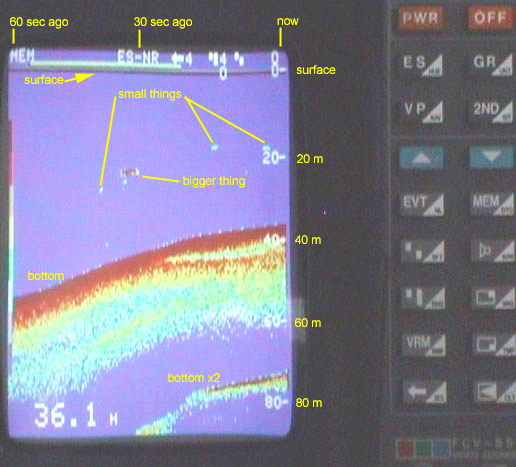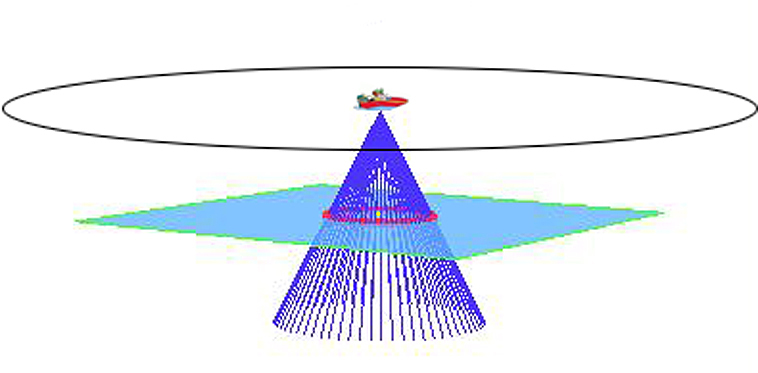
From time to time people on boats see unusual images on their fish-finder sonar screens, and if they are on Loch Ness there is always the possibility of accidental misinterpretation. Let us take a look at a photo of a sonar screen I took while on the Loch Ness Project's boat MV Deepscan near Urquhart Castle.

To help you understand what the picture means I have added some labels in yellow. The machine sends out pulses of sound several times a second and records the echoes as a coloured mark on the screen. Stronger echoes make stronger colours, ranging between white for weak, through pale blue, green, yellow, orange and finally red. The longer it takes for the echo to come back to the boat, the further down the screen it will be marked. After each "pulse and listen" cycle the image on the screen is moved one pixel ( more or less, according to requirements) to the left so that the echo from the next pulse can be recorded. Gradually, a picture builds up and moves from right to left, showing what was within the sound beam over the previous minute or so. "Now" at the surface is at the top right of the screen, "Now" at the far end of the range chosen - in this case 80 metres - is at the bottom right.
One important thing to know is that the sound beam isn't a narrow beam like a laser, but a gradually widening cone, and worse still, there can be more than one of them, called "side lobes". The diagram below shows a small boat with a single sonar beam underneath it - no side lobes in this case.

This is a first attempt at a 3-D diagram showing a chap in an inflatable boat on the surface. The sonar "beam" is the blue cone going downwards, getting ever wider and weaker as it heads for the bottom of the loch. The pale blue plane is called the thermocline - a layer of water present during the summer in which the temperature changes rapidly , dropping several degrees Celsius in a metre or so. It is often found at a depth of around 20 metres in Loch Ness, and the change of temperature is associated with a change of density which causes tiny organisms and debris to collect here. This in turn attracts small fish, which attract larger ones and their predators.
The diagram shows a red ring where the beam passes through the thermocline. It is clear from this diagram that something on the thermocline at the outer edge of the beam, on the red ring, is further away from the sonar machine than some other thing at the same depth but directly under the boat, marked here with a yellow spot. School geometry tells us the distance to the red ring is the "hypotenuse" of a triangle, while the distance to the yellow spot is the "adjacent" side.
So far we have only thought about a single object on the thermocline. Sometimes there may be only one detected, sometimes none at all, and sometimes tens or even hundreds of them, plankton organisms, tiny fish, bigger fish and debris like leaves. Under these conditions the sonar will show them as a narrow and often weak band 2 or more metres thick on the screen.
All of this makes interpretation of a fishfinder sonar screen very subjective, and there is a common saying among experienced operators that "to understand the sonar screen you must first know what is there."
Copyright Dick Raynor 2012
Click here to go back to the homepage
All images are Copyright
© Dick Raynor 2012